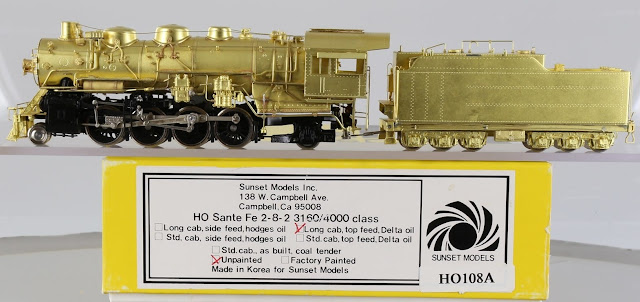This time we'll take a look at the Union Pacific's Alco FA-1 and FB-1 mainline diesel freight locos that operated through Victorville, and then we'll look at the final improvements to the lower deck staging yard designs.
From June of 1947 through September of 1948 the UP acquired 44 FA-1 cab units and 44 FB-1 booster units, enough to assemble 22 ABBA sets of 6,000 HP per set, in its effort to dieselize its California mainline freight operations.
Here is UP FA-FB set #1603 climbing the grade westbound at Frost, just after leaving Victorville, as shot by Frank Peterson in Oct. 1950:
The sets acquired in 1947 were numbered in the 1500-series, but they were all renumbered to the 1600-series during 1948. Most photos show them in their 1600-series numbers.
Here is set #1603 again in Oct. 1950, this time stopped beside the Victorville Wye (see the boiler house and elevated fuel tank at the left), waiting for UP steam helper #5092, a 4-10-2, to be added for the climb up Cajon Pass:
Here we see an ABBA set of FAs and FBs heading west past the Riverside cement plant at Oro Grande, heading to Victorville, as shot by Donald Duke circa 1950:
Here is UP FA-FB set #1611 waiting to depart the B Yard in San Bernardino, headed east to Cajon Pass and Victorville in April 1950, as shot by Jack Whitmeyer:
Here's another UP FA-FB set, working hard as it climbs west out of the Upper Narrows at Victorville, as shot by Donald Duke:
Here's one final action shot as FA-FB set #1603 climbs westbound out of Victorville's Upper Narrows in Oct. 1950:
The UP's FA-FB sets operated over Cajon Pass from 1947 until sometime in 1954, when they were replaced by new GP9s from EMD.
There have been many HO-scale models of the UP's FA-1s and FB-1s. Here are the Walthers Trainline models, which used to be made by Train Miniature:
Note that models have been made with the early 1500-series numbers as well as the 1948+ 1600-series numbers.
Here are the Proto 2000 models:
And here are the HO models from MTH:
Rapido is now planning to make super-detailed models of these locos. My models came from both Proto 2000 and Train Miniature.
Turning now to progress on my layout design for the lower staging deck, I erased and drew some new stub-ended yards and moved some crossovers to make an improved Version 4 track plan, which I hope is the final design.
I've checked that each train and each loco can get to where it needs to go. Sometimes there will be back-up moves, such as backing a train into a stub-ended storage yard after its run.
Here is the revised track plan for the main peninsula:
Here is the revised turntable area drawing:
And here is the revised helix room drawing:
Here's Version 4 of the straight-line schematic drawing of the tracks, with new labels for some of the yards (the old D Yard in the helix room is now called the F Yard):
I remeasured the storage capacities for all the tracks that had changed, and here are the new numbers:
I think my next steps are to move a few legs on the benchwork, add a plywood triangle in one spot, sand down the joints between sections, and add shims and wood filler between some joints. Then the track lines can be drawn on the plywood.

























